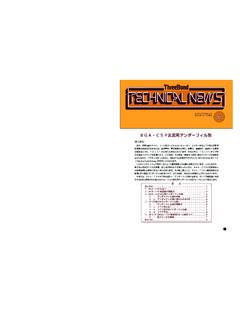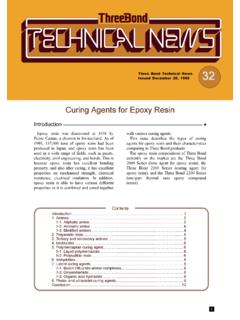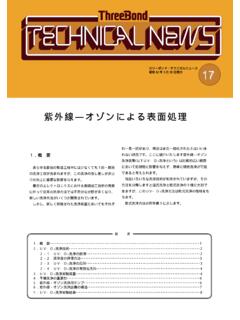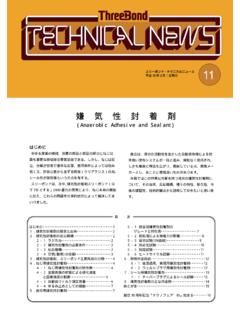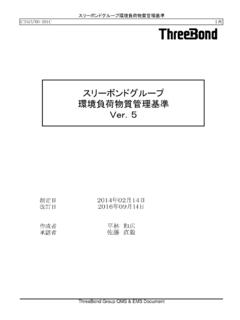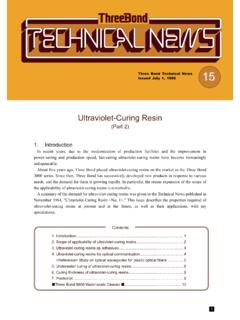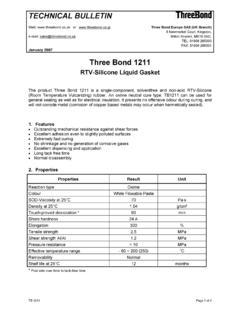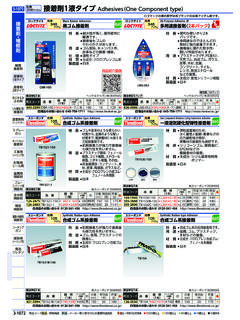Transcription of Structural and Engineering Adhesives - …
1 three bond Technical News Issued Dec. 20, 1991. Structural and Engineering Adhesives Introduction The Structural adhesive 1) 2) is defined (JIS K6800) as a Engineering Adhesives are also categorized as Structural highly reliable adhesive which has less deterioration in the Adhesives . Engineering Adhesives are specialty Adhesives , bonding properties even with long-term excessive loads. which are curing at room-temperature, nonsolvent, and liquid-reactive Adhesives and provide high performance Structural Adhesives were fully applied for automobile brake structure strength.
2 They include six types of Adhesives : linings which started to be used around 1960 for industrial epoxy, modified acrylic, anaerobic, cyanoacrylate, urethane, use in Japan. In those days, brake shoes and linings had been and silicone. This issue introduces the types, characteristics, joined using rivets, but now all brake linings for automobiles and applications of these Structural Adhesives and newly are bonded with Adhesives . Structural Adhesives were studied developed room-temperature curing Engineering Adhesives . to be applied for aircrafts in 1930s outside of Japan.
3 Many countries including Britain and the United States actually used structure Adhesives for aircrafts in World War II. Today, Structural Adhesives are fully applied for automobile, rolling stock, electronics, building, Engineering , and space industries, and they are considered to develop new applications as the leading edge Adhesives for composite materials. Contents Introduction .. 1 4-3. Anaerobiotic Structural Adhesives ..7. 1. Characteristics of Structural 2 4-4. Cyanoacrylate ..8. 2. Types of Structural 2 4-5. Urethane ..9. 3. Performances of heating-curing one-part epoxy 5.
4 Applications of Structural Adhesives and Engineering Adhesives .. 3 Adhesives ..9. 4. Types and performances of Engineering Adhesives 5-1. Applications of Structural Adhesives ..9.. 4 5-2. Applications of Engineering 4-1. Epoxy Adhesives .. 4 Conclusion ..10. 4-2. Modified acrylic, second-generation acrylic Adhesives (SGA) .. 6. 1. 1. Characteristics of Structural Adhesives Structural Adhesives have the following advantages when (3) Sealant effects used in place of weldings, rivets, and bolts. Continuous films are formed to seal joint parts.
5 (1) Bonding between different materials (4) Smooth surfaces and good appearances We cannot weld different materials; however, by The Adhesives do not make bumps that rivets and using Adhesives we can join metals with glasses and bolts cause or weld overlays. Without rivets and FRPs. bolts, bonded objects can be lighter and smaller. (2) Uniform dispersion of stress (5) Electrical insulation Rivets or bolts centralizes stress on a joint part. The Adhesives provide good electrical insulation However, glued connection can disperse stress layers to prevent electrolytic corrosion caused by uniformly by joining surfaces, decrease material contacts with different kinds of metals.
6 Fatigue caused by oscillations, and increase fatigue strength. Also, this reduces oscillations and prevents (6) Bonding durability noises. The Adhesives provide excellent durability including adhesion performances, heat resistances, and chemical resistances. 2. Types of Structural Adhesives Structural Adhesives require resistances for heat, water, standards for aircraft structure). Table 21) shows the and chemicals as well as adhesion performances such as types and curing conditions of composite Adhesives shearing, peeling, bending, and creep resistance.
7 Corresponding to the segments in Table 1. Typical Therefore, composite Adhesives containing thermal- composite Adhesives include vinyl-phenolic, nitrile- curing resin with thermoplastic resin or synthetic rubber phenolic, epoxy-phenolic, nylon-epoxy, and nitrile- take a major role to provide powerful adhesive strength epoxy, etc. As a curing condition, they are bonded by by heat curing. Testing standards for Structural Adhesives heat and pressure at 180 to 200 C. These Adhesives are have not been established in Japan. Table 1 shows the used for automobile parts such as disk pads and clutch federal standards MMM-A-132A ( adhesive testing facings in addition to aircrafts.)
8 Table 1. Requirements for Structural Adhesives for aircrafts (MMM-A-132A). Type I. Testing Item Testing Condition Type II Type III Type IV. Class 1 Class 2 Class 3. 24 C 387 246 211 193 193 193. 82 C 10min 193 141 141. 149 C 10min 158 141 141. Peeling and 149 C 192h 158 141 141. shearing 260 C 10min 130 130. strength (kgf/cm2) 260 C 192h 70. 55 C 10min 387 246 211 193 193 193. 49 C, 95 to 100 % RH 30 after days, 316 228 193 193 193 176. 24 C, immersion in liquid after 7 days 316 228 193 193 176 176. T-type peeling 24 C (kgf/25mm) 23 9. strength Blister 24 C (kgf/cm2) 316 228.
9 Detection Fatigue 24 C 106 cycles at 53kgf/cm2. strength 24 C 112kfg/cm2 Maximum deformation mm for 192 h Type I 82 C 112kfg/cm2 Maximum deformation mm for 192 h Creep Type II, III 149 C 56kfg/cm2 Maximum deformation mm for 192 h breakdown Maximum Type IV 260 C 56kfg/cm2 deformation mm for 192 h Note: adhesive , HEAT RESISTANT, AIRFRAME Structural , METAL TO METAL (1982-11-22). 2. Table 2. Types and curing conditions of Structural Adhesives for aircrafts Performance adhesive type Curing condition Type Class (Line) C h kgf/cm2. I 1 Nylon-epoxy 180 1 2.
10 2 Modified nitrile-epoxy 120 1 to 3 Vinyl-phenolic 180 2 14. II Nitrile-phenolic 180 1 3. III Nitrile-phenolic IV Epoxy-phenolic 180 3. Epoxy-phenolic Polyimide 260 to 370 3 to 14. 3. Performances of heating-curing one-part epoxy Adhesives The development of Adhesives for general industries strength, creep bonding strength, heat resistance, and focuses on improving bonding strength and heat chemical resistance. Also they are used for electrical and resistance and on lowering curing temperature. In place electronic related products due to the excellent electrical of composite Adhesives described above, epoxy characteristics.

